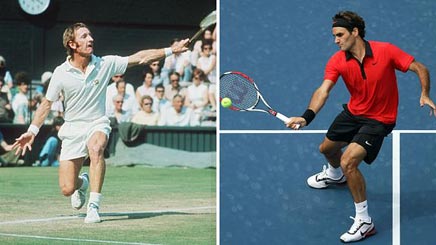JANUARY 2010:
DEBUNKING THE MODERN GAME
Make that the so-called "modern game." There’s a serious faux pas resulting from such an inappropriate label, one which tennis has now been saddled with for a few years by both those whose job it is to create marketing hype for the financial welfare of the game, and especially those who hype some imaginary new unique instructional genre to, mostly, create a grandiose perception of themselves. I know, shocking in today’s world of rising disingenuousness.
The result? The now fully embraced connotation, or fallout, is that all that preceded this new "era" is outdated and irrelevant. To discredit all that has preceded what’s current is a sharp stick in the collective eye of the uber talents who, over many years, built the foundation upon which today’s game is played at its highest level.
Rod Laver, still the only player to capture a calendar-year Grand Slam – twice (first in '62 during tennis' shamateurism days, and in '69 at the dawn of the "open era"), understood the game better than anyone, to this day, when he said, "It's a simple game, but it’s just not easy." Nothing has changed despite all the tinkering and the accompanying critical tom foolery.

It is important to note that Laver, the left-handed Aussie wizard, was not playing "modern tennis" in those '60s, as it is being defined today. Pete Sampras was not playing it in the late '80s and throughout the '90s when he dominated, and still is not while tearing it up in junior veteran tour events around the globe. And Martina Navratolova has never exemplified it, beginning in the '70s to right now. So what are these people talking about?
Yes, of course, the athletes of today have become bigger, stronger, faster, quicker in all sports, best exemplified in sports such as track and field and swimming where stop watches plot the steady advances inhuman physiology. Think Usane Bolt, Michael Phelps, and Dara Torres, who like Navratolova, continues to excel into her forties.
Does that mean that Jesse Owens, Roger Bannister, Mark Spitz, and Wilma Rudolph are written off as antiquated? I think not!
Exactly what is this "modern game" that we’re supposed to be embracing? Consider the primary example of how the game is being taught by the new breed of USPTA led brainwashed coaches of today. A Western grip, or even an extreme Western grip, on the forehand is now favored in order to avoid striking the ball in front of one’s body, while purposely allowing it to travel well into the backside of the hitting zone. Why? In order to make contact off of one's back hip to facilitate the necessity of brushing violently up the backside of the ball in a fully-opened stance from well behind the baseline!
Does the rash of tour hip injuries now come to mind, the kind that ended the careers of two fairly recent world #1 modern day warriors, Guga Kuerten and Magnus Larsen, along with a host of other finely tuned tennis athletes using their bodies inefficiently? And what’s up with the myriad injuries that the 22 year old Rafael Nadal suffered in the 2009 season while strutting this "modern" approach?
Is that how Roger Federer, relatively injury free at 28 and today’s premier model player, plays his forehand in this "new" day and age? No! He strikes it well ahead of his body with an Eastern forehand grip, even when slightly open-stanced, in order to hit mostly through the ball, albeit with some topspin to bend it into the court at the higher shot speed of today’s game, just as Rod Laver had to back in his day but with a far less lethal wooden racket (Dunlop Maxply Fort) and slower balls, but with a tree trunk of a forearm.
While practicing recently with a player whose game came of age in the '80s, compared to my, by comparison, ancient development in the '60s, an interested sports savvy spectator remarked to me after our session: "It was interesting to see the difference between your games." Upon asking him whose game more closely resembled Federer’s game – key word being resembled – his response was that my game was a much closer match.
- The flattened out forehand, with some topspin, versus the loopy topspin of my practice partner struck late.
- My more versatile one-handed backhand, both with topspin and a skidding slice, compared to his one-dimensional, two-handed topspin stroke.
Now we have these lightweight frames – the biggest difference between the rackets of today and those first generation "graphites" introduced in the late '70s, make no mistake about it – that these bigger, stronger players, male and female, can accelerate through the ball with blazing speed. Interestingly, those that choose to flatten out their groundies, best exemplified recently by Juan Martin del Potro’s surprise win over the always ethereal Federer at the ’09 US Open doing just that, are praised for their ball striking approach by the TV announcing crews in these "modern" times. And when you consider Maria Sharapova among others, and Lindsey Davenport before her, the "modern" tennis being advocated by today’s teachers as the Holy Grail is not so evident. Curious indeed.
Okay, so why did Jimmy Connors and John McEnroe continue to play fairly flat even in their later years when their equipment had been ultimately turboized? Because they could! Because they were taught how to hit through the ball when the opportunity presented itself while still incorporating the nuances of spin, including underspin when appropriate, versus those who seldom ever deviate from leaving fuzzless bald spots on the backs of balls while feverishly hitting up on them to the nth degree, in full bludgeoning mode, at times even following through backwards!
Just because the dirt-ballers of the world tour, who’ve been playing this now "modern tennis" for decades on clay, and who, as a group, have stepped up to the plate in recent years and embraced the challenge of playing on hard courts with ball-striking techniques best suited for clay, is not even close to being reason enough to attempt to proselytize an entire generation of up and coming players to play "modern."
So in the end what should we be thinking on this subject? That there is no new game altering, revolutionary, strictly "modern" component. It does not exist. It is what it is in the lexicon of the day – a constantly evolving work in progress built upon a regimen of core axioms that are the essence of the game, then and now.
As in life, everything in balance, and everything in moderation is still best.
Questions and comments are welcome at anytime for all tips present and past via email.
This Tip of the Month is copyright© by Jak Beardsworth Tennis. All rights reserved. Copies may be made only with the permission of and by Jak Beardsworth. Contact him here.
Tips Archive
- May, June, 2013 JUST TALKING HEADS OR MORE [read more]
- March, April, 2013 SELF-TALK: Good, Bad, or Indifferent [read more]
- January, February, 2013 BOOK-A-MILLION: Do Tennis Players Read? [read more]
- December, 2012 THE KEY TO TOUR LEVEL BALL STRIKING: And How to Learn It [read more]
- November, 2012 ARE YOU A THUDDER, A TWANGER, OR A PINGER: Racket Dampeners [read more]
- September, October, 2012 SMART SHOTS [read more]
- July, August, 2012 TEN TOP STRESS REDUCERS [read more]
- June, 2012 MAKING YOUR LESSONS STICK [read more]
- May, 2012 THE IMPOSSIBLE: Accelerating and Decelerating Simultaneously [read more]
- April, 2012 PLAYER DISCONNECTION [read more]
- March, 2012 BENDING THE SERVE IN [read more]
- February, 2012 UNDERSTANDING TERMINOLOGY: Drill vs Clinic vs Team Practice [read more]
- January, 2012 PLAYING SCARED? [read more]
- December, 2011 CUTTING OFF THE ANGLE…VERTICALLY [read more]
- November, 2011 WHY COACHING? [read more]
- October, 2011 THE EASY BALLS ARE NOT EASY [read more]
- August/September, 2011 NEVER TOO LATE FOR OLDER DOGS [read more]
- June/July, 2011 HARD COURTS, SOFT COURTS, and YOUR BODY'S ADAPTATION [read more]
- April/May, 2011 JAW DROPPNG [read more]
- March, 2011 CLUB DOUBLES' INCREASINGLY MISSING LINK [read more]
- February, 2011 TIP 2 | POOH POOHING DOUBLES STRATEGY SESSIONS [read more]
- February, 2011 TIP 1 | CLAY TO HARD, HARD TO CLAY [read more]
- January, 2011 ICING THE SERVER WHEN RECEIVING IN THE BIG MOMENTS [read more]
- December, 2010 JOHN ISNER’S “GOOD MISS” [read more]
- November, 2010 THE MOST NEGLECTED SHOT IN THE GAME [read more]
- October, 2010 BALL BOUNCING and the SERVE [read more]
- September, 2010 TAKE YOUR EYE OFF THE BALL [read more]
- July-August, 2010 SUMMER SCHOOL COURTSIDE CRIB SHEET [read more]
- May-June, 2010 THE 2-HANDED JUMP BACKHAND: The Dumbest Shot in Tennis [read more]
- April, 2010 THE STANDING AROUND SYNDROME [read more]
- March, 2010 THE ELUSIVE SERVICE TOSS [read more]
- February, 2010 PREPARING TO START THE POINT: Serving and Receiving [read more]
- January, 2010 DEBUNKING THE MODERN GAME [read more]
- December, 2009 RELAX – IT'S JUST A RALLY BALL [read more]
- November, 2009 DEFEATING THE POACHER [read more]
- October, 2009 PRACTICE, PRACTICE, PRACTICE [read more]
- September, 2009 SERVING SUCCESS: Warming-Up vs Match Play [read more]
- August, 2009 THE SPLIT STEP: Defending the Court, Rushing the Net, and More [read more]
- July, 2009 THE THIRD GROUNDSTROKE [read more]
- June, 2009 HOW MANY HANDS DOES IT TAKE? [read more]
- May, 2009 THE MOST IMPORTANT SKILL [read more]
- April, 2009 PLAYING IN THE FLORIDA WIND [read more]
- March, 2009 Letting them Play for Peak Performance in Clubland [read more]
- February, 2009 SUPPORTING YOUR GAME [read more]
- January, 2009 RESPECTING THE GAME: Top 10 Do's & Don'ts [read more]
- December, 2008 Getting the Warm-up Right [read more]
- November, 2008 Visualize...Realize: The Mind Body Connection [read more]
- October, 2008 Reading Their Mail [read more]


